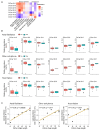Ceramide Synthase 2 Promotes Cardiac Very-Long-Chain Dihydroceramide Accumulation and Is Linked to Arrhythmias and Heart Failure in Humans
- PMID: 40725105
- PMCID: PMC12295622
- DOI: 10.3390/ijms26146859
Ceramide Synthase 2 Promotes Cardiac Very-Long-Chain Dihydroceramide Accumulation and Is Linked to Arrhythmias and Heart Failure in Humans
Abstract
Acute myocardial hypoxia/ischemia is associated with abnormal accumulation of myocardial lipids, including dihydroceramides. Here, we characterized how dihydroceramides are remodeled in response to hypoxia and assessed how dihydroceramide remodeling correlates to human cardiac pathophysiology. Hypoxia resulted in a marked accumulation of very-long-chain (VLC)-dihydroceramides in cultured HL-1 cardiomyocytes. In humans, we identified a correlation between the abundance of VLC-dihydroceramides in myocardial biopsies and arrhythmias and heart failure and showed that cardiac expression of CERS2, coding for an enzyme that promotes synthesis of VLC-dihydroceramides, was associated with signaling pathways linked to cardiac arrhythmia and cardiomyopathy. In cultured HL-1 cardiomyocytes, we showed that CerS2 knockdown reduced accumulation of VLC dihydroceramides and altered the expression of mediators regulating Ca2+ cycling and electrical conduction. In conclusion, our findings indicate that increased abundance of VLC-dihydroceramides, promoted by increased activity of CerS2 in response to hypoxia, could play a role in cardiac arrhythmias and heart failure.
Keywords: bioactive lipids; cardiac sphingolipids; ceramide synthase; dihydroceramide; hypoxia.
Conflict of interest statement
Author Marcus Henricsson was employed by the company AstraZeneca. The remaining authors declare that the research was conducted in the absence of any commercial or financial relationships that could be construed as a potential conflict of interest.
Figures





Similar articles
-
Deep sphingolipidomic and metabolomic analyses of ceramide synthase 2 null mice reveal complex pathway-specific effects.J Lipid Res. 2025 Jul;66(7):100832. doi: 10.1016/j.jlr.2025.100832. Epub 2025 May 29. J Lipid Res. 2025. PMID: 40449731 Free PMC article.
-
IL-10 constrains sphingolipid metabolism to limit inflammation.Nature. 2024 Mar;627(8004):628-635. doi: 10.1038/s41586-024-07098-5. Epub 2024 Feb 21. Nature. 2024. PMID: 38383790 Free PMC article.
-
Mechanistic Relevance of Ventricular Arrhythmias in Heart Failure with Preserved Ejection Fraction.Int J Mol Sci. 2024 Dec 14;25(24):13423. doi: 10.3390/ijms252413423. Int J Mol Sci. 2024. PMID: 39769189 Free PMC article. Review.
-
Cardiomyocyte-Specific Long Noncoding RNA Regulates Alternative Splicing of the Triadin Gene in the Heart.Circulation. 2022 Aug 30;146(9):699-714. doi: 10.1161/CIRCULATIONAHA.121.058017. Epub 2022 Jul 18. Circulation. 2022. PMID: 35862102 Free PMC article.
-
Dexrazoxane for preventing or reducing cardiotoxicity in adults and children with cancer receiving anthracyclines.Cochrane Database Syst Rev. 2022 Sep 27;9(9):CD014638. doi: 10.1002/14651858.CD014638.pub2. Cochrane Database Syst Rev. 2022. PMID: 36162822 Free PMC article.
References
-
- Perman J.C., Bostrom P., Lindbom M., Lidberg U., StAhlman M., Hagg D., Lindskog H., Scharin Tang M., Omerovic E., Mattsson Hulten L., et al. The VLDL receptor promotes lipotoxicity and increases mortality in mice following an acute myocardial infarction. J. Clin. Investig. 2011;121:2625–2640. doi: 10.1172/JCI43068. - DOI - PMC - PubMed
-
- Klevstig M., Stahlman M., Lundqvist A., Scharin Tang M., Fogelstrand P., Adiels M., Andersson L., Kolesnick R., Jeppsson A., Boren J., et al. Targeting acid sphingomyelinase reduces cardiac ceramide accumulation in the post-ischemic heart. J. Mol. Cell. Cardiol. 2016;93:69–72. doi: 10.1016/j.yjmcc.2016.02.019. - DOI - PMC - PubMed
MeSH terms
Substances
Grants and funding
- 2021-02610 (M.C.L.)/Swedish Research Council
- 20230600 (MCL)/Swedish Heart-Lung Foundation
- 20240724 (A.J.)/Swedish Heart-Lung Foundation
- 1007021, (M.C.L.)/the Swedish state under the agreement between the Swedish government and the country councils, the ALF-agreement,
- 1006697 (A.J.)/the Swedish state under the agreement between the Swedish government and the country councils, the ALF-agreement
LinkOut - more resources
Full Text Sources
Medical
Miscellaneous

